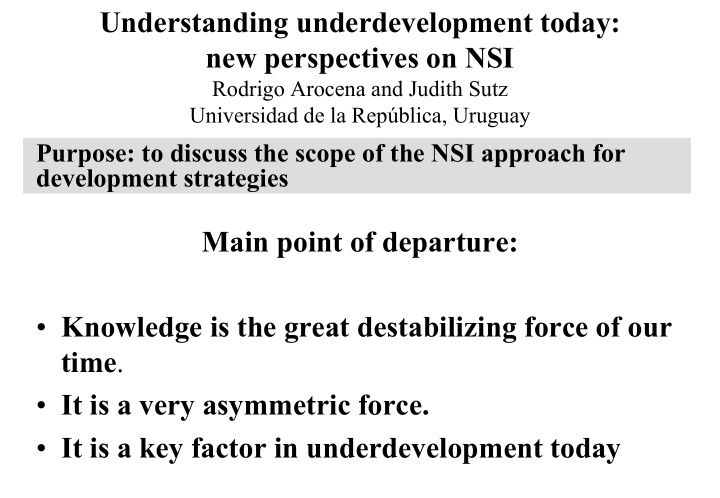



Understanding underdevelopment today: new perspectives on NSI Rodrigo Arocena and Judith Sutz Universidad de la República, Uruguay Purpose: to discuss the scope of the NSI approach for development strategies Main point of departure: • Knowledge is the great destabilizing force of our time . • It is a very asymmetric force. • It is a key factor in underdevelopment today
We shall develop two set of ideas: I.- When applying the II.-To use the NSI NSI approach to approach to devise new underdeveloped countries, development strategies, we should not give for it is useful to pay careful granted that key features attention to some issues for the smooth functioning with specially strong of innovation systems are relevance in present there. underdevelopment.
( I.a ) We should not give for granted that in underdevelopment the growth in capabilities will be accompanied by the growth of opportunities to creatively apply them. The future of these countries depends on that combination, that is, on the growth of learning possibilities Interactive learning spaces are opportunities to apply creatively North knowledge capabilities. The R&D as % North is interactive learning of GDP spaces rich while the South is poor. G ro s s G ro s s R & D a s % o f R & D a s % o f e n ro llm e n t in e n ro llm e n t in G D P G D P H ig h e r H ig h e r South E d u c a tio n (% ) E d u c a tio n (% ) D e v e lo p e d D e v e lo p e d 5 0 5 0 2 ,2 2 ,2 c o u n trie s c o u n trie s Higher Education D e v e lo p in g D e v e lo p in g 8 8 0 ,6 0 ,6 c o u n trie s c o u n trie s The main divide between North and South is a “learning divide”
We should not give for granted either that • (I.b) NSIs in underdevelopment behave in a systemic way: (ex-ante character of NSI) processes of diffusion are frequently truncated • (I.c) NSIs will “naturally” evolve towards some suitable stage. Even acknowledging that there are no models for NSIs, normative guidance is needed • (I.d) Innovation is not hampered by conflict and power relations: those who fight to open interactive learning places have substantially less power than those concerned mainly with buying innovations abroad • (I.e) The State is a strong and knowledgeable agent the dynamics and quality of public policy is a central issue
II.- Some issues to take into account when applying the NSI approach to devise new development strategies ( II.a)Inequality and Innovation: how do they interact? � High inequality hampers innovation in the long run… � But promoting equity does not ensure learning , so equity may not be sustainable It is useful to distinguish between two forms of equity “Pro-active” equity “Re-active equity” that enhances innovation that hampers innovation capabilities and thus and so only attempts to enables sustainable equity assure a short-term and highly vulnerable equity Where do we find pro-active equity? What does it mean to foster pro-active equity?
(II.b) Public perception of science, technology and innovation � the legitimacy and efficiency of innovation policies are related to the opinions and expectations of different strata of population � opinions and expectations mold the way people relate to S,T & I and this impinges in the evolving shape of national identities � the degree of public awareness of endogenous research highly influences collective attitudes towards S,T & I Conjecture: this issue affects the prospects of NSI in underdeveloped countries The “technological imaginary” of a population is a main influence on the current dynamics of learning and innovation
(II.c)“Bio-innovation”: ¿a new window of opportunity? � From a development perspective, bio-innovation is important because: • Biodiversity is highly concentrated in underdeveloped countries • Life is always context specific, so local knowledge is needed to solve problems • Research on life sciences is often strong in the South � A fundamental challenge is to go beyond “what should not be done”, to influence the way bio-innovation is developed and applied. This needs better structured National Systems of Innovation � Bio-innovation has direct application to problems that affect the most vulnerable part of the population. Factors promoting or hampering socially committed research agendas can be studied with particular deepness
(II.d) Global Regulatory Systems � “multilateral systems of governance” are greatly influential concerning issues related to innovation (propriety rights and regulations of all sorts): they set “border conditions” for innovative trajectories and � the capability of nations to defend their interests in international regulatory instances are quite uneven This is an issue to integrate into the NSI framework • bio-diversity is being If these trends persist, the severely damaged; negative perception of science • patents are granted to a vast and technology in backward array of information about sectors and countries will biological processes increase
Innovation policies understood as development strategies i) should be inspired by � “gardening” concerns (taking care for the existing strengths) and include � bottom-up based designs (taking as a point of departure operating interactive learning spaces) ii) should focus on National Innovation and Diffusion Systems as a way to take into account Sen’s emphasis on seeing people as agents and not as patients iii)should fight against short-termism by undertaking systematic foresight; this is an important tool for NIS building and gardening policies
To take into account for further research: NIS is a widely used concept. The approach has acquired a sort of social responsibility. It must keep on looking for new perspectives.
Recommend
More recommend